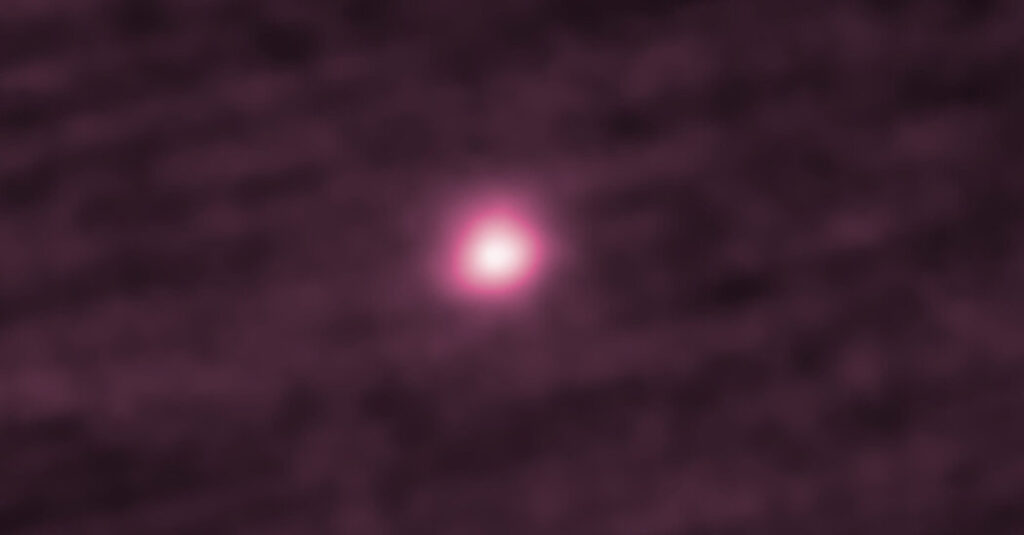Month-old photographs of a comet do not typically fuel conspiracy theories of an imminent alien invasion.
But this is not quite an ordinary comet; 3I/ATLAS came from beyond the solar system and is now on its way back out to the empty interstellar reaches of the Milky Way. The federal government’s recent 43-day-long shutdown added to the intrigue.
Spacecraft near Mars, including NASA’s, pointed their cameras at 3I/ATLAS when it zoomed past the red planet in early October. But during the U.S. government shutdown, the images from the NASA spacecraft remained out of sight. Space agency officials did not even acknowledge that the pictures existed.
NASA finally put them out on Wednesday, for all the world to see.
“I’d like to address the rumors right at the beginning.” Amit Kshatriya, the associate administrator of NASA, said during the news conference. “This object is a comet. It looks and behaves like a comet.”
He and other NASA officials presented a series of images taken by the fleet of spacecraft, including the Mars Reconnaissance Orbiter, the Lucy mission, which is headed for fly-bys of asteroids trapped in Jupiter’s orbit, and the Solar and Heliospheric Observatory.
”It’s a little bit as if our NASA spacecraft were at a baseball game watching the game from different places in the stadium,” said Tom Statler, the lead scientist at NASA for solar system small bodies. “Everybody’s got a camera, and they’re trying to get a picture of the ball, and nobody has a perfect view, and everybody has a different camera.”
The image taken by Lucy shows a backlit comet. “We could not get this view from the vantage point of the Earth,” Dr. Statler said. The various views from different spacecraft and ground-based telescopes could allow scientists to assemble a three-dimensional view, he said.
Measurements of the comet show that it is unusual in some ways compared with those that formed within the solar system. But none of those quirks would indicate it was something sent by an alien civilization.
“We haven’t seen any technosignatures,” said Nicola Fox, the associate administrator for NASA’s science mission directorate, using the word preferred by scientists to describe potential extraterrestrial technology.
Dr. Statler said 3I/ATLAS had notable differences from solar system comets, among them the ratio of carbon dioxide to water and the ratio of nickel to iron. The light reflected off dust shed by the comet was “unusual,” he said, indicating that the distribution of dust grains according to size might be different.
But, he added, the differences were like what a drinker of Hawaiian Kona coffee might notice when trying a brew from a different part of the world for the first time. “It’s different, and yet it’s still coffee,” he said.
The high-resolution camera on the Mars Reconnaissance Orbiter captured a relatively close-up view, from just 19 million miles away. But that camera is designed for taking photographs of the bright surface of Mars. The image it made shows a bright center and a cloud of gas and dust, known as a coma.
“It’s a smeared image,” Alfred McEwen, a professor of planetary geology at the University of Arizona and until recently the principal investigator for the camera, said in an interview. “The spacecraft is designed to be stable over 10 milliseconds for imaging Mars, but this is like a three-second exposure.”
Because of the smearing, it will probably not provide better estimates of the size of the comet nucleus. In July, scientists using the Hubble Space Telescope said the comet was no wider than 3.5 miles in diameter and possibly even as small as 1,400 feet. At the time, the comet was more than 270 million miles from Earth, and Hubble.
While the new image could yield information, Dr. McEwen said, “there’s nothing obvious that jumps out.”
He added, “It definitely looks like a comet. Yes, it’s fuzzy. It’s got a coma. Doesn’t look like a spacecraft.”
The comet was first spotted in July by telescopes on Earth. Last month, it made its closest approach to the sun, passing just inside the orbit of Mars. Scientists know it must have arrived from interstellar space because of its high speed, reaching more than 150,000 miles per hour. It is now on its way out from the solar system.
Avi Loeb, an astrophysicist at Harvard, has provoked wider interest about Comet 3I/ATLAS. He has speculated that it could have been sent by aliens, given some of its peculiarities.
Dr. Kshatriya said he thought the attention was wonderful. “It expanded people’s brains to think about how magical the universe could be,” he said.
He noted just a few months ago that NASA scientists had presented results about an intriguing rock on Mars that could include signs of past life.
The comet was out of view from Earth for a couple of months because it was on the other side of the sun.
“Getting data at a time when none of the ground-based telescopes can observe it is very valuable,” Karen Meech, a planetary astronomer at the University of Hawaii, wrote in an email. “This includes estimates of the brightness and getting estimates of the amount of gas coming off the comet.”
She noted measurements of hydrogen emissions made by MAVEN, another NASA spacecraft orbiting Mars. Hydrogen is produced by sunlight breaking apart water molecules, and the brightness of the emissions “will ultimately tell us how much water was coming off the comet,” Dr. Meech said.
There are more observations yet to be made. The comet will come closest to Earth on Dec. 19, when it will be some 170 million miles away. Next spring it will pass by Jupiter, and NASA’s Juno spacecraft in orbit there can take a look.
Kenneth Chang, a science reporter at The Times, covers NASA and the solar system, and research closer to Earth.
The post NASA Releases Images of Comet 3I/ATLAS: It ‘Doesn’t Look Like a Spacecraft’ appeared first on New York Times.




